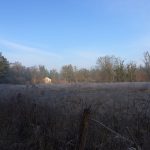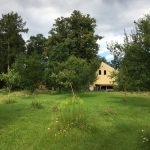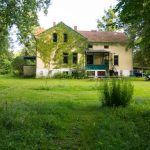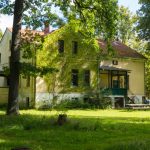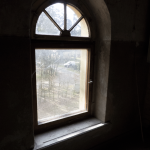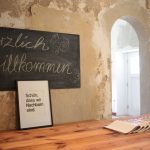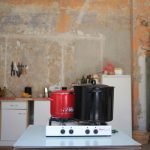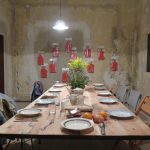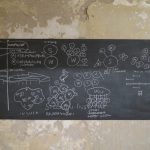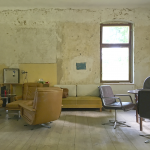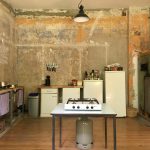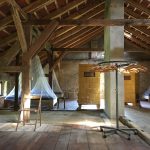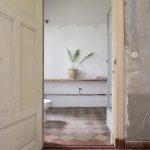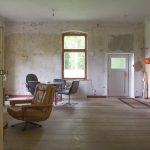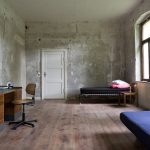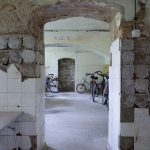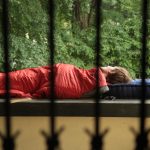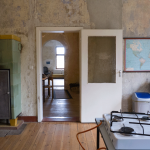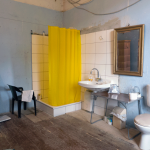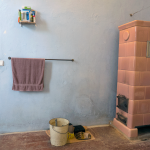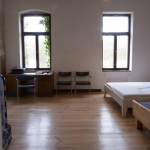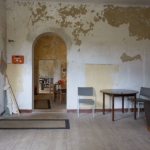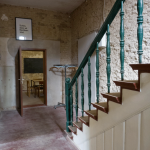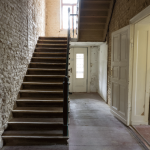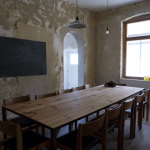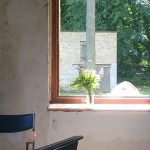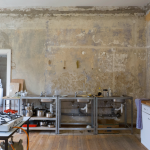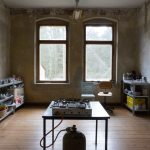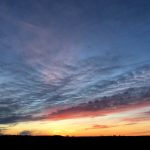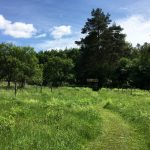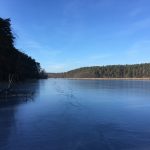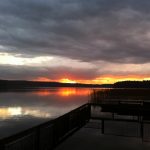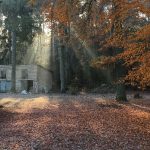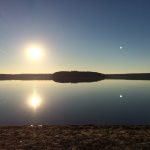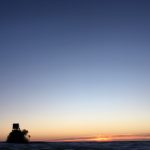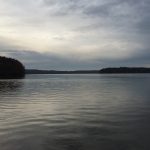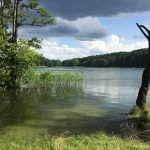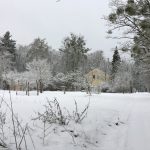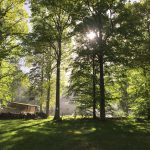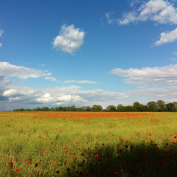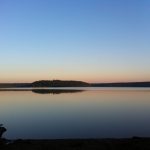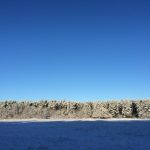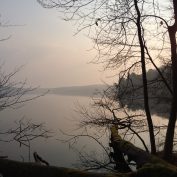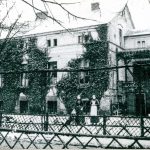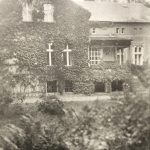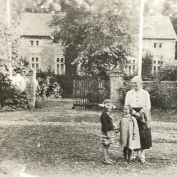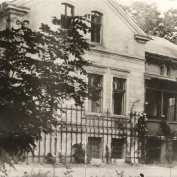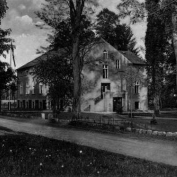Institut
In the forest near the formerly clear Stechlinsee 80km north of Berlin stands the former manor house Neuroofen. We want to open up the house and develop the place artistically sustainable, socially and ecologically. An inclusive place, dedicated to people who get involved, for whom debate and insight are not enough. Those who intervene and act, who bring new ideas (ideals) into the world and test them. We are convinced of the power of artistic thinking and social commitment. Integrative thinking and relativizing anthropocentrism are a necessity and resource for positive convivial* change (*living together with animate and inanimate nature). The SI is an artistic blueprint for sufficient living, solidary cooperation, knowledge transfer and persistent problem solving.
At the Stechlin Institute, we have created a space that sharpens the senses, sensitizes, and reminds to take responsibility for one’s being, the other and oneself. Not only to see man centrally, but to fit into the complex system earth and humbly to take back, equally embedded next to all living things in a decaying, seemingly intact nature.
The SI is a resonance space for people who are aware of the upcoming social and ecological change, stand up and not only oppose the resistance of revisionist forces with a new awareness of the living, but also try to preserve living spaces and, in the best case, to regenerate. We want to enrich the free space created with knowledge and test in a rural context to what extent sustainably sufficient living is possible.
Labratory
„The scientists of the Intergovernmental Panel on Climate Change (IPCC) tell us clearly that our actions or inactions in the 2020s will determine the living conditions on Earth for the next thousand years.“ Maike Sippel, Professor of Sustainable Economics, Konstanz University of Applied Sciences (Technology, Economics and Design) in the taz.
„… what holds the world together at its core is its relational structure.“ Hans-Peter Dürr, physicist, member of the Club of Rome
The enlightened, Western man subjugates the earth, places himself above equal relationships, eludes ecological coherence, intervenes and destroys functioning natural structures.
The acceleration of dysfunctional systems, human arrogance and limitless extraction suggest that we must tear essential tipping points and sooner or later manage the collapse of human civilization.
Our chance is now to intervene to make the 6th mass extinction, which affects human civilization equally, at least somewhat humanistic. It’s worth a try…
Place
The global North has messed it up. And there is no hope for trend-setting states that resist the power of fossil fuel industries, restrict platform capitalism, and implement climate targets restrictively. This is precisely why we try to build up the place in the local convivial* (as a living relationship structure). We want to find out how it works to create a place in harmony with life where social purposes are equated with the natural. We will not subordinate forests, trees, lake and soil to human needs. We don’t want to seal, build anything new, no concrete, we don’t want to harm the environment. We will use our artistic expertise to develop this house aesthetically in such a way that old and new complement each other and functionally expand. In the spaces created in this way, necessary technology and artefact are left in formal harmony and the environment is not put on the back burner. We want an attractive building in which people and groups can find themselves comfortable and work optimally adapted (spatial structure). We want to find out whether it is possible to create a space without major damage in which people become socially and physically aware that human impact is also sustainable for future generations. Sufficient and beautiful.
We want to make it visible that less can be more. It does not take much to live in coherence with the natural and living in a consensual non-extractive way, that human conditions do not have to be based on industrial norms.
The acceleration of human surplus is irrelevant for living together. There is no need for limitless overconsumption in a world that is bursting at the seams in the face of civilizational garbage. We want to shape life here with people in which everyone can contribute and work.
In this way, the residents of the house experience and shape their own self-efficacy in their climate-sensitive options for action, i.e. the design of their own stay in the house lies in the assumption of responsibility that is necessary for appropriate, energetic processes in the house. In concrete terms, this means that we disclose the heating concept to those present and the execution into their own hands. They can design and regulate their own heat consumption. In addition, the connection between wood processing (collection, splitting, hoeing) and heating for hot water supply and space heating can be physically experienced.
House
It is an old house staying cool even in hot weather. Every one of its three floors is about 200 squaremeters. At the moment, we are using two of these floors for living. There are enough beds for 15 people. The main floor can be heated, the top floor under the roof (mainly for sleeping) is not insulated yet.
Our wifi connects via broadband, but mobile reception in this area is rather low.
The house is not barrier-free yet.
Rooms
Most rooms are spacious and open – this means, there are no single or double rooms. The dining table fits everyone easily, the fireside room overflows with couches, and tiled fireplaces serve to make the main floor very cozy. There are two showers, three toilets, 15 beds, two fridges and three kitchen sinks. You can move your beds freely around the house.
Surroundings
Around the house lies a huge field of grass with fruit trees giving shade in the summer. Big Lake Stechlin is located perhaps three kilometers through the forest. Lake Roofen in the other direction is also nice for swimming and taking long walks.
There are local producers all around. The Faradgang fixed a bunch of bikes for the Institut which you can use to explore the area and go on food hunts. To the eco farmer, fisherman, forester, supermarkets, bakers, or bee-keepers…
History
The manor of Neu-Roofen was founded by a Prussian family in 1872 who wanted to use their land for agriculture. As a sandy glacial frontal plain, the ground didn’t yield well, so they sold their fields one after the other, and at one point also swapped their house with the forestry department. In the meantime, Neuroofen grew into a small hamlet in the middle of a forest where foresters and lumberjacks were trained. Under the National Socialists, the house was extended, and for a few days in 1945, the Oberkommando der Wehrmacht was based here. After the war, the house served as a refugee home before the forestry department returned in the GDR. Some time in between then and now, it also was a summer camp for children, a shop, and a youth club. These different usages and many inhabitants have all left their traces. After this changeful history, the foundation Stiftung Edith Maryon bought the house for the Stechlin-Institut in 2014. When we moved in, we first stripped the house down to its oldest walls. A barrier-free renovation is planned for the coming years.
Art
Socially engaged art
There has been a history of roughly 100 years to socially engaged art. Artistic practice in this field understands itself beyond the symbolic as a tool of immediate social transformation. Today, a growing number of artists are beginning to consciously return to the social. The Stechlin-Institut sees itself as an actor in the field of socially engaged art. It wants to activate the social potential of artistic thinking and expand the scope of artistic action. The Stechlin Institute sees itself as an actor in the field of socially engaged art. It aims to make the potential of artistic thinking socially effective and to expand the scope of action of art.
Art at the Stechlin-Institut
Like Cornelius Castoriadis, we are convinced of the creative imagination of humans as the inexhaustible “source and origin of otherness and perpetual self-alteration of a society.” And this, in fact, does not only concern artists. Artistic or oblique thinking is an emancipatory process. Bernhard Waldenfels attributes a special ability to artists, being able to stand ambiguity. One could say it like this: Artists make visible what is invisible. They don’t change that which is disturbing – they create another perspective on it altogether. Art is a discipline, a process which renders deviation, the surprising, and the superfluous visible in order to break routine experience and perception.
Climate justice and the socio-ecological transformation of our society are among the greatest challenges of our time. In „The Great Transformation – Introduction to the Art of Social Change“, Uwe Schneidewind, former president of the Wuppertal Institute and member of the Club of Rome, explicitly speaks of the future artist as a driver of the necessary change. Artists rely on their gut feeling, overcome ambivalences and then create incredible things with limited means. From our artistic experience and our serious instinct to play, we can develop new narratives on the way to a post-fossil future in a mindful and sustainable way. Low-threshold, but with a lot of passion, we artists can do our part to design and implement transformation processes for a sustainable future worth living.
Also the temporary retreat to rural surroundings is a strategy from the context of art, aiming at overviewing and clarifying. That teams of non-profit organizations and artists are living together first of all means a confrontation with a strange, or at least different, life plan. It should be mentioned, though, that artists are confronted with the same insecurity of the situation. When these actors are in encounter, it is therefore at eye level, and everybody involved can find the potential of reflecting their own situation.


